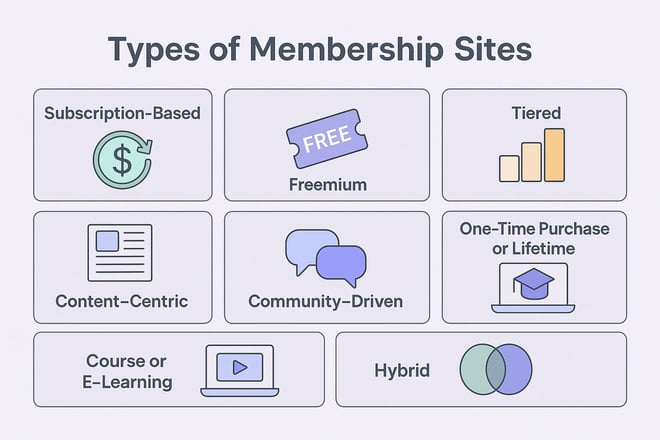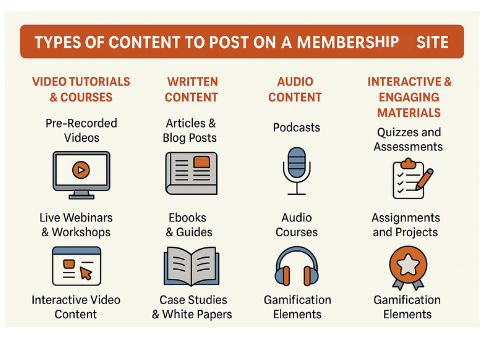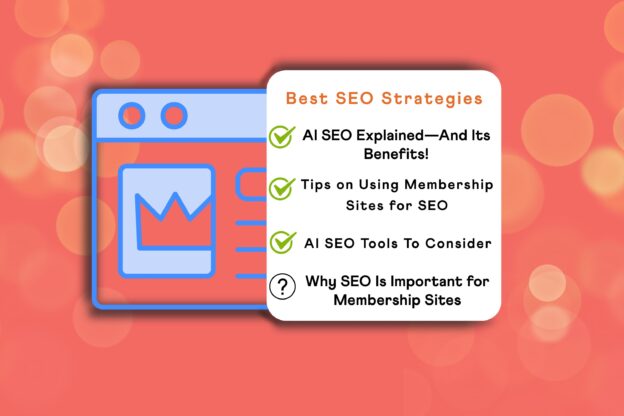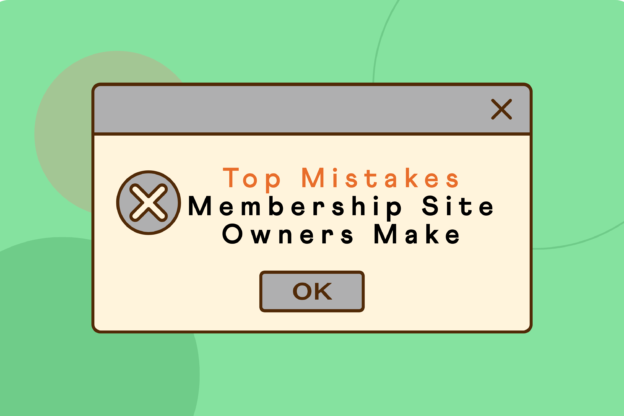In an era where everyone wants to be part of the “in-crowd,” membership sites have exploded in popularity, offering a sustainable way to create recurring revenue and build a vibrant community.
Also, membership sites now account for a staggering portion of recurring revenue for many creators and businesses? It’s almost as if people prefer paying for VIP access rather than free cat videos online. This is the reason why a huge number of membership sites are being created to provide its members exclusive content and earn from its membership every year.
You might now want to create a membership site or maybe never have heard of it. Don’t worry this article will guide you through the basics and above about everything in detail.
What Are Membership Sites And Why Do You Need it?
If put it simply, Membership sites are online platforms where access to exclusive content, resources, or community features is limited to members; typically those who pay a recurring fee or sign up for a specific subscription.
Instead of offering all your content for free, when you create a membership site, you get full control over what you share and with whom, creating a private space where loyal followers, enthusiasts, or professionals can access premium resources, learn specialized skills, or even just enjoy the perks of being part of an exclusive community.
Create a Membership site If you are under any of these:-
Entrepreneurs and Content Creators
If you’re a blogger, podcaster, or online influencer, your audience already believes in your expertise. A membership site offers a way to monetize trust and enthusiasm by delivering premium, exclusive content that digs deeper than your free offerings. Think of it as turning casual followers into dedicated fans who pay for the inside scoop.
Coaches, Mentors, and Consultants
For professionals offering personalized guidance, memberships allow you to package your expertise into a structured system. Whether you’re offering webinars, one-on-one sessions, or exclusive resources, your members gain consistent value while you enjoy a predictable, recurring income.
As Jim Rohn (American entrepreneur and author) famously noted,
“If you really want to do something, you’ll find a way. If not, you’ll find excuses.”
A membership site is one way to ensure you’re finding the way instead of settling for excuses.
Educators and Online Course Creators
Membership websites are a natural extension of online education. They provide a space for ongoing learning beyond a single course, allowing educators to update content, foster discussion, and continuously support their students. It’s like having a digital classroom that never closes.
Brands and Organizations
Established brands can use membership sites as a loyalty and retention tool. By offering exclusive deals, early product access, or behind-the-scenes content, you turn your loyal customers into an engaged community. This not only strengthens brand affinity but also creates a steady revenue stream that isn’t as volatile as one-off sales.
Hobbyists and Community Builders
Even if you’re not a “big brand,” if you’re passionate about a subject—be it gardening, gaming, or gourmet cooking—you can build a membership site that attracts like-minded individuals. These niches often thrive on the intimate connections and specialized knowledge shared within a tight-knit community.
Different Types Of Membership Sites
There are multiple types of membership sites and below we have discussed all 8 of them. These types will help you identify and understand the purpose of each so you can choose which is best for you to create a membership site around.

1. Subscription-Based Membership Sites
The classic model where members pay a recurring fee (monthly, quarterly, or annually) for continual access to your premium content. This approach works great if you plan to regularly update the site—think of it as the Netflix of your niche. It’s ideal for creators who love generating predictable, recurring revenue.
2. Freemium Membership Sites
Here, you offer essential features or content for free, while reserving the juiciest, premium content for paying members. It’s like letting someone sample your dish before they decide to order the full meal. This model helps attract a broader audience, converting free users into paying subscribers over time.
3. Tiered Membership Sites
Not all members are created equal (or at least they don’t have the same needs)! Tiered models give users multiple levels of access at different price points. For instance, a basic tier might offer standard content, while a premium tier provides exclusive webinars, one-on-one coaching, or other high-value perks. It’s a win-win: more value for your top fans and flexibility for new subscribers.
4. One-Time Purchase or Lifetime Membership Sites
For those who hate the idea of monthly fees as much as you hate untimely auto-renewals, lifetime memberships or one-time payment structures provide access to content for as long as the site exists—or at least for a very long time. If you create a membership site on this model can generate a substantial upfront revenue boost, though you’ll need to keep delivering value to avoid buyer’s remorse.
5. Content-Centric Membership Sites
These sites focus primarily on an ever-growing library of content, such as articles, videos, podcasts, or downloadable resources. Perfect for educators, writers, or industry experts, this approach turns your vast reservoir of expertise into a curated, members-only resource hub.
6. Community-Driven Membership Sites
At their core, these sites thrive on building relationships. Beyond content, they offer dedicated forums, discussion groups, or live Q&A sessions where members connect and share ideas. Think of it as the digital version of a private club—where the network is the net worth.
7. Course or E-Learning Membership Sites
Designed for educators and trainers, these platforms combine the benefits of online courses with the recurring revenue of a membership. They often include structured learning paths, certifications, and interactive sessions, transforming a one-off course into an ongoing educational journey.
8. Hybrid Membership Sites
Can’t decide which model fits best? Hybrid sites mix and match elements from the above types. For example, you might offer a freemium model with tiered options, or combine subscription-based content with one-time purchases for exclusive workshops. Flexibility is key—after all, the best membership sites evolve based on audience feedback and emerging trends.
And let’s not forget—membership websites are not the same as subscription sites or online courses, even though we often treat them interchangeably. As Simon Sinek wisely noted,
“People don’t buy what you do; they buy why you do it.”
(This rings true for memberships: your passion and unique value proposition will convert browsers into loyal subscribers.)
Benefits of Membership Sites
Why jump on the membership bandwagon? Here are a few reasons:
- Recurring Revenue: Forget the feast-or-famine cycle of one-off sales.
- Community Building: Develop a loyal tribe that values what you do.
- Control Over Content: Decide who sees what and when—no more accidental giveaways!

For those who cringe at the idea of coding, tools like MemberPress let you build a no-code membership site faster than you can say “subscription signup.” As any discerning online entrepreneur knows, sometimes less code means more fun—and fewer headaches.
8 Steps to Create and Manage Your Membership Site
Ready to build your digital clubhouse? Follow these simple (yet comprehensive) steps:

1. Select and Choose Your Niche and Audience
Before you create a membership site, take a moment to identify exactly who you’re speaking to. This isn’t just a casual, “Oh, I like this topic” decision—it’s a strategic move that shapes every aspect of your site.
Narrowing down your niche is like setting the GPS coordinates for your digital journey. You need to know your destination before you hit the road.
Start by asking yourself, “What is my passion and expertise, and who is most likely to benefit from it?” Dig into market research: explore forums, social media groups, and industry publications to understand the needs and habits of potential members.
Craft a detailed profile of your ideal audience. For instance, if your heart beats for vegan cuisine, then your ideal members are likely those searching for plant-based recipes and healthy living tips—not die-hard steak lovers (unless you’re ready to handle a kitchen rebellion).
2. Pick a Membership Model
Now that you’ve pinpointed your niche and audience, it’s time to decide on your membership model to create a membership site—the blueprint for how you deliver value and generate recurring revenue. Imagine your membership offering as if you were designing an engaging online course.
You need to determine the structure, the modules, and the pathway through which your students (or members) will progress. Consider these options:
- Subscription-Based: Think of this model as a live, continuously updated course. Your members pay a recurring fee—monthly or annually—to access ongoing lessons, workshops, and fresh content. It’s like enrolling in a course that never truly ends, where every module builds on the previous one, ensuring your audience keeps coming back for more knowledge.
- Freemium: With this approach, you offer a free introductory module—a taste of what’s to come—while locking away the in-depth, advanced lessons behind a paywall. This model is perfect for attracting a wide audience: once they’re hooked on the preview, the promise of more comprehensive content compels them to upgrade to the full course.
- Tiered Membership: Here, you design multiple “course tracks” that cater to different levels of engagement. The basic tier could be your foundational course, offering essential lessons and resources. The mid-tier might include additional interactive components like live Q&A sessions or downloadable materials, while the premium tier provides an all-access pass with exclusive one-on-one mentorship, advanced workshops, and VIP content.
3. Pick a Membership Software
Picking the right membership software is like selecting the perfect vehicle for your educational journey—you need something that’s reliable, fits your driving style (or technical comfort level), and meets your destination needs.
Even if you prefer the familiarity of a robust WordPress plugin or a sleek, all-in-one solution, the key is to pick a tool that aligns with your expertise and long-term goals.
For instance, if you’re already comfortable with WordPress, MemberPress stands out as a powerful and customizable option.
It integrates seamlessly with your existing site, offers granular control over content access, and supports various payment gateways, making it a favorite for DIY enthusiasts who enjoy tweaking and optimizing their systems.
Its strong community support and extensive documentation ensure that even if you hit a snag, help is just a forum post away.
On the other hand, if you’re looking for an all-in-one platform that bundles website hosting, email marketing, automation, and membership management into a single package, Kajabi might be your go-to choice.
Kajabi is designed to streamline the entire process from course creation to subscriber management, letting you focus more on content and less on backend hassles. Its user-friendly interface is perfect for those who want to get started quickly without worrying too much about technical minutiae.
Don’t forget, there are several other contenders in the membership software arena, such as Teachable, Thinkific, and Podia, each with its own unique features and pricing plans. As you weigh your options, consider factors like scalability, ease-of-use, integration capabilities, and customer support. After all, the best software is the one that grows with you and minimizes your tech headaches, letting you devote more time to creating the awesome content your members will love.
Try MemberPress Today
MemberPress Customers Pass the $1 Billion Benchmark—and Yours Could Be Next
4. Develop and Upload Content
Before you start developing your content and upload it to your membership site take a look around and see if you have previously made blogs, Youtube videos, any article or recorded lectures or webinars. If yes then collect them all and revise it and polish it to upload on your site.

Later plan a thought and structure content and include all these below content type or at least some of them:-
Video Tutorials & Courses:
Pre-Recorded Videos
Live Webinars & Workshops
Interactive Video Content
Written Content:
Articles & Blog Posts
Ebooks & Guides
Case Studies & White Papers
Audio Content:
Podcasts
Audio Courses
Interactive & Engaging Materials:
Quizzes and Assessments
Assignments and Projects
Gamification Elements
Community-Driven Content:
Discussion Forums & Message Boards
Member-Generated Content
With a blend of these content types, you create a rich, multifaceted learning environment that caters to different preferences and learning styles. This diversity not only enhances the user experience but also increases the perceived value of your membership site.
5. Member Onboarding and Marketing Preparation
When welcoming new members, imagine you’re rolling out the red carpet for VIPs.
Start by crafting a simple, fun welcome guide that acts like a treasure map—showing them where to find all the exclusive goodies on your site.
Follow this up with a personalized email series that greets them with a friendly, “Congratulations, you’re now part of the cool club!” tone.
A short, interactive walkthrough or video tutorial works wonders to demystify your platform, almost like teaching them the secret handshake to your exclusive community.
And don’t forget to nudge them into joining your forums or social media groups, where they can quickly feel at home among fellow insiders.
On the marketing front,
Ditch the boring promotions and opt for an engaging, personality-packed approach.
Create content that’s not only informative but also sprinkled with wit—think blog posts, videos, and social media updates that resonate and entertain.
Instead of broadcasting generic ads, use targeted social media campaigns that feel like personal invitations. A fun referral program can also be a game-changer by rewarding your current members for inviting new ones; it turns every member into an enthusiastic promoter.
With emails that come off as friendly catch-ups rather than hard-sell spam and occasional memes to keep things light, your marketing strategy will build excitement and draw in curious, eager new members.
Learn More
The Best Email Marketing Sequences for Membership Sites And Online Communities
6. Security, Maintenance, and Legal Considerations
Keep your membership site safe, sound, and legally solid with a few straightforward steps:
Security:
- Use SSL certificates to encrypt data and keep sensitive information safe.
- Schedule regular backups to avoid any data loss.
- Always update plugins and software to protect against security threats.
Maintenance:
- Regularly check your site’s performance to catch issues early.
- Fix any glitches quickly to keep the user experience smooth.
Legal Basics:
- Draft clear legal policies (terms of service, privacy policy, etc.) to protect both you and your members.
- These policies help build trust and keep miscreants from causing trouble.
Simple measures like these make sure your site stays secure and trustworthy, keeping your members happy and your membership site protected.
7. Monitor Your Site’s Progress
Keep an eye on your membership site’s performance by using analytics tools to track user behavior, churn rates, and overall engagement.
Regularly review this data to understand which content or features resonate with your audience, and which areas might need a little extra polish. When you notice trends—like a spike in certain activity or a gradual drop in retention—take it as a cue to adjust your strategy accordingly.
Don’t be afraid to experiment: Modify your content delivery, refresh your engagement tactics, and even run A/B tests to see what works best.
Remember, every piece of feedback is a goldmine of insights.
As Mark Cuban famously said, “Sweat equity is the most valuable equity there is.” In other words, investing your time in analyzing performance and iterating based on real user feedback will pay off in the long run.
Keep monitoring, keep learning, and keep refining your approach to ensure your membership community stays vibrant and engaged.
Top WordPress Plugins for Membership Sites (No Code Required)
MemberPress
MemberPress is a comprehensive WordPress membership plugin that offers robust features for creating and managing membership sites. It allows you to create unlimited membership levels with customizable pricing plans, including one-time payments, recurring subscriptions, and trial periods. The plugin provides powerful access rules to restrict content based on membership levels and supports content dripping to release content over time. Additionally, MemberPress integrates seamlessly with various payment gateways and third-party services, enhancing its functionality.
Restrict Content Pro
Restrict Content Pro is a user-friendly membership plugin known for its simplicity and flexibility. It enables the creation of unlimited membership levels, including free, trial, and premium subscriptions. The plugin offers robust content restriction options, allowing you to control access to posts, pages, and custom post types. It also includes features like discount codes, detailed reporting, and integrates with multiple payment gateways such as Stripe, PayPal, and Authorize.net. Restrict Content Pro provides a streamlined interface, making it accessible for users without technical expertise.
Paid Memberships Pro
Paid Memberships Pro is a versatile membership management plugin that offers a wide range of features and add-ons. It supports multiple membership levels with flexible pricing and access control. The plugin allows for content restriction by posts, pages, and custom post types, and includes customizable checkout processes. Paid Memberships Pro integrates with various payment gateways and provides a dedicated theme for those starting from scratch. Its extensive add-ons enable advanced functionalities like recurring payments and email marketing integration.
Create A Membership Site: Final Thoughts
To all those thinking that it is a hard core job to create a membership site, requiring a huge budget then I hope this guide has made you understand that it’s not as hard as it looks. You define your niche, choose the right tools, create awesome content and nurture your community.
Still have doubts about where to start? Here take a look at MemberPress. The #1 trusted and reliable Platform for Creating Membership Sites.












